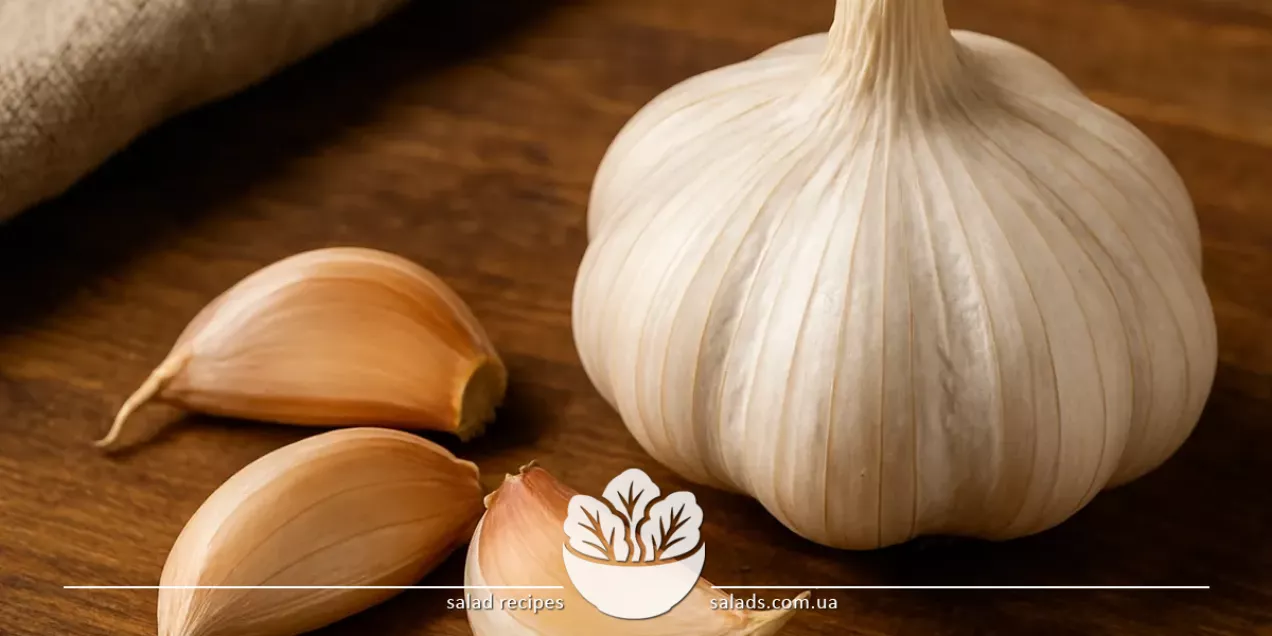
Garlic

Garlic is one of the oldest and most valuable culinary ingredients, known for its pungent aroma and its ability to completely transform the taste of a dish. It is used as a base seasoning in vegetable, meat, fish, and vegetarian recipes. Fresh garlic adds sharpness to raw salads, marinades, and sauces, while cooked garlic becomes milder in taste and softer in texture. This ingredient is widely used in cooking and pairs universally with other products. In the garlic section, you can find more ways to use it in various types of dishes.
Garlic Salad Recipes
Garlic in Salads and Dressings: Intense Aroma and Flavor Accent
Fresh garlic is often used as a fragrant base in salads, especially in dressings and sauces. Thanks to its strong sharpness, it gives even the simplest dishes a distinctive character. Raw garlic is added to green, vegetable, or grain salads in the form of thin shavings, grated purée, or finely chopped. The most common combinations include garlic with olive oil, lemon juice, mustard, or yogurt, which create a balanced and rich dressing. Salads with garlic are often complemented by vegetables with a neutral taste, which balance its pungency. For example, in salads with beans, broccoli, tomatoes, or spinach, garlic acts as a flavor enhancer. It also pairs well with soft cheeses and grains such as couscous, bulgur, and quinoa. When mixed with roasted eggplant pulp and herbs, it becomes a fragrant paste or Eastern-style dressing. Garlic dressing goes well with legume-based dishes. For example, a salad of boiled white beans, fresh vegetables, and garlic is a nutritious and aromatic dish that tastes great both cold and at room temperature. In salads, garlic is not just a spice but an element that can set the tone of the entire dish, making it brighter and more memorable.
Garlic in Hot Dishes: Flavor Notes After Cooking
Cooked garlic changes its flavor and aroma – from sharp and pungent to mild, slightly sweet, and deep. That’s why it is widely used in hot dishes – from soups to casseroles, stewed vegetables, meat, and fish. Fried, stewed, or roasted garlic becomes more than just a spice – it turns into a full ingredient that forms the flavor base of many traditional and modern recipes. Garlic sautéed in oil is usually added at the beginning of cooking – it infuses the oil with aroma and sets the base for further ingredients. This is a common technique in preparing vegetable stews, pilafs, pastas, and sauces. In casseroles, garlic is added either fresh or sautéed – it pairs well with potatoes, zucchini, eggplants, and tomatoes. In soups – especially creamy ones – it’s sautéed with onions or added as a purée for a more expressive taste. One of the most effective combinations in hot dishes is the pairing of garlic and tomatoes. For example, in recipes with tomatoes, garlic plays a key role, enriching the tomatoes’ acidity and softening their taste. This duo is often used in pastas, vegetable stews, and baked dishes. Cooked garlic creates a mild and pleasant aroma, easily accepted even by those who don’t enjoy raw garlic.
Garlic in Appetizers and Spreads: A Spicy Accent with No Effort
Garlic is a key ingredient in many cold appetizers and spreads due to its ability to instantly enrich flavor. It’s used raw or roasted to create pastes, sauces, hummus, sandwich creams, and even as a standalone snack. For spreads, garlic cloves are typically processed into a purée-like consistency, sometimes with other ingredients – cheeses, vegetables, legumes, or nuts. One of the most popular recipes is garlic paste with oil, salt, and herbs, ideal for toast, flatbread, or fresh vegetables. Another option is mixing garlic with cream cheese, yogurt, or sour cream for a soft, creamy texture. This kind of paste is perfect as a spread or dip for veggie sticks, chips, or roasted potatoes. Garlic in appetizers pairs excellently with other aromatic ingredients. For example, you can make a spread based on eggplants and garlic or a spicy hummus with sautéed garlic. A particularly interesting option is a pâté made from roasted eggplants, garlic, and lemon juice, which tastes great with flatbread or whole grain bread. These appetizers are easy to prepare, keep for several days, and always have a rich, balanced flavor. In these dishes, garlic is not just a spice but the main flavor note.
Garlic in Meat and Vegetable Fillings: Spicy Depth for Stuffed Dishes
Garlic is an essential component in many stuffed dishes, where it not only enhances the aroma of the filling but also balances other ingredients. With its bold pungency, it pairs well with meat mixtures, vegetable blends, and grain combinations. It is added both fresh and sautéed – as a paste, chopped clove, or even whole roasted purée. In dishes where the filling has a delicate taste, garlic provides the necessary contrast. A classic example is cabbage rolls or stuffed vegetables with meat, rice, herbs, and garlic. It’s also widely used in fillings for baked mushrooms, rolls, pies, or peppers. In dishes with milder ingredients like rice, cheese, or vegetables, garlic acts as a flavor booster, requiring only a small amount for a noticeable effect. An interesting example is filling made with boiled eggs, onions, herbs, and garlic – perfect for pastries or stuffed vegetables. This option pairs especially well with chicken eggs, which soften garlic’s sharpness, creating a gentle yet expressive flavor profile. Thanks to its versatility, garlic easily integrates into any filling, making the dish richer, more appetizing, and memorable.



